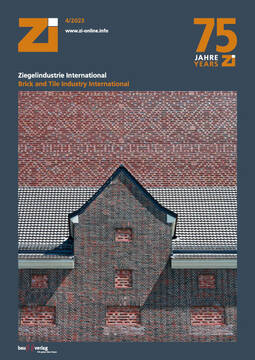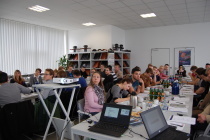The mortar of the industry
What makes a trade journal like ‘Brick and Tile Industry International’? A look at the topics of the first issue, which appeared in November 1948 under the name ‘Die Ziegelindustrie’, (The Brick Industry) offers a first clue. Questions that the ZI addressed at that time were: How can the demand for heavy clay products caused by the reconstruction of the war-damaged cities be satisfied? How can the supply of energy and energy sources, at that time mainly coal, to the brickworks be ensured? How can the shortage of skilled workers be met? What does the planned change in the brick format standard mean for its structural-physical properties and the manufacturer? What advantages does a vacuum press offer in terms of production processes and product quality?
Fortunately, the situation today is different from what it was back then. In 1948, Germany was still largely in ruins, and the economy, politics and society were still trying to find a new beginning. Environmental protection played no role in public or political life. But the questions asked in the ZI today are substantially much the same as they were then, differing only in form. For example: What predictable perspective will there be for the secure and economically viable supply of green thermal energy? How can the recyclability of the building material brick be expanded? How can the energy efficiency of the plants for preparation and shaping be increased? What makes an attractive employer in the brick industry? This applies in particular and of course to production technology and product standards.
The ZI has accompanied, commented on, discussed and also archived the changing shape of these quasi-eternal topics of the brick industry. The articles in which these topics were dealt with mostly came from the industry itself. A few brief glances at the ZI archives of the past 25 years are enough to see how diverse and colourful the topics of the brick industry are. Here is a small selection:
Technology and research, e.g.
‚Perlite – a new mineral filter for the promotion of sintering in the ceramic industry‘ (ZI 7/1991)
‚Fast firing technology in the brick and tile industry – a technical evaluation (ZI 3/1993)
Plant presentations, e.g.:
‘Shuang Ya Shan Brickmaking Plant – Spontaneous combustion of carboniferous shale’ (ZI 11/1992)
‘Master in the art of blue-reduced roofing tiles – the Alphons Meyer KG roofing tile factory in Emmerich-Vrasselt, Germany’ (ZI 6/2010)
Standardisation, e.g.:
‘The Problem of building a brick house in Europe‘
(ZI 7-8/1993)
‘Fire protection with clay unit masonry: European standardization – new fire tests‘ (ZI 10/2013)
Events/conferences/student excursions, e.g.:
‘100 years for the brick - an association celebrates its birthday’ (ZI 8/1997)
‘50th Würzburg brick course - a successful anniversary’
(ZI 1-2/2012)
‘Successful Zi field trip to a clay roofing tile plant’
(ZI 1/2015)
Brick markets and industries worldwide, e.g.:
‘Uruguay - bricks in the Mercosur’ (ZI 5/2000)
‘”Good firing” for the Bulgarian brick and tile industry’
(ZI 5/2002)
History of the industry, people and technology, e.g.:
‘From craft trade to industrialization – Industrialization of the brikmakers‘ trade and its social consequences in Northern Germany in the 19th century‘ (5/1993).
‘Modern continuous production began with the advent of the box-feeder - now celebrating its centenary‘ (5/2006)
There was also space for more marginal topics, e.g.:
‘Habitat for a limited period: Tree frog in open pit quarrying‘
(ZI 2/1995)
‘Pigeons, drinkers, horsemen - the pottery centres of the Contenin’ (ZI 1-2/2000)
This diversity of topics exceeds the knowledge horizon of a single person. Prepared in articles written by experts in the different subject areas of brickmaking and disseminated in the ZI, the topics diffuse across the sector. The effect is knowledge acquisition and transfer, communication, further development and engagement - and thus also togetherness. The exchange between the members of the sector is the mortar of the sector. The ZI, as the medium and memory of this exchange across places and times, cannot be separated from it.
In the end, this is what makes the ZI, that it enables the industry to communicate with itself. The proud age of 75 years is impressive proof of how successfully the journal has fulfilled this function.
This success story would not have been written without the constant commitment and interest we have experienced from the industry. On behalf of the ZI editorial team, we would like to express our sincere thanks for the excellent editorial cooperation with brick manufacturers, machinery and plant manufacturers, suppliers, researchers, associations, institutes and societies in Germany and worldwide. We would also like to express our sincere thanks to our advertising partners who have substantially supported the publication of the journal for 75 years. We have dedicated a page to our closest partners as an expression of this gratitude, which will appear again in the following two issues. Finally, we would also like to thank you, our loyal and critical readers.
Our wish is to continue this success story and to continue to serve as a mortar for the brick and tile industry in the coming 75 years. Therefore, I would like to ask you to continue your editorial and promotional cooperation with us. Send us your topics, contributions, concerns and wishes. Tell us your news from plants and production, plant development, committees, associations and societies, chairs and research institutions, museums and markets. Because only together with your support can we continue to form the mortar of the brick and tile industry.
I would like to refer once again to the first issue of ZI and quote the appeal made by Ernst Rauch, then chairman of the predecessor of the Federal Association of the German Brick and Tile Industry, in his foreword: “May our trade journal act as a link between East and West, may it be a mediator for the entire German brick and tile industry. If these wishes, which we are giving it on its way to its launch, are to be fulfilled, all circles of our industry must cooperate energetically. Each in his own way: one in advertising, the other in enlightening scientific and practical essays. Help us all! That is the call, and by fulfilling it, everyone will be serving himself and the “brick and tile industry” in a double sense. The higher the standard of our journal, the greater the success, which lies solely in the respect for the joint work of our industry and in the attention paid to our journal. If we can achieve excellence here, we will thereby also build bridges to the brick industry of other countries and make their experiences evident to us as well.”







